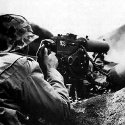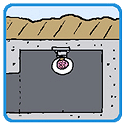|
Veins McGee posted:http://en.wikipedia.org/wiki/Flagship#Naval_use Historically, to be "the" flagship of the Navy, the admiral in charge of the entire fleet would have to operate from a ship. In WWII, Yamamoto flew his flag in Nagato and then in Yamato, so those ships could plausibly be described as the flagships of the IJN. Operating from a ship was very unwise. In modern warfare, radio direction finding ensures that anyone broadcasting at high power can be located fairly easily, which jeopardizes operational security. Whenever Yamamoto set sail, he had to stop giving orders to any ships not operating directly with the flagship. That rather ruins the point of being commander in chief. In the US, admirals at the level of Nimitz or King remained ashore and could give orders to their fleet commanders as they liked, making their jobs much easier.
|
|
|
|

|
| # ? Jun 10, 2024 02:52 |
Zorak of Michigan posted:Historically, to be "the" flagship of the Navy, the admiral in charge of the entire fleet would have to operate from a ship. In WWII, Yamamoto flew his flag in Nagato and then in Yamato, so those ships could plausibly be described as the flagships of the IJN. Operating from a ship was very unwise. In modern warfare, radio direction finding ensures that anyone broadcasting at high power can be located fairly easily, which jeopardizes operational security. Whenever Yamamoto set sail, he had to stop giving orders to any ships not operating directly with the flagship. That rather ruins the point of being commander in chief. In the US, admirals at the level of Nimitz or King remained ashore and could give orders to their fleet commanders as they liked, making their jobs much easier. Maybe I misunderstood his question. I thought he was talking about flagships in general and not "Flagship of the Navy". There was still subordinate admirals who flew a flag from a warship afloat in order to coordinate the actions of their assigned ships. Nimitz was CinC Pacific Fleet. He commanded the US Pacific Fleet in WWII from ashore. He issued orders to his subordinate admirals, for example Halsey or Kinkaid, who controlled their respective fleets from aboard ship(For example, Halsey did so from aboard both the Missouri and the Entreprise and I assume various other ships).
|
|
|
|
|
Rent-A-Cop posted:The decline in the deployment of tank destroyers really had more to do with the development of good dual-purpose guns on medium tanks than anything else. When it became clear that the medium tank, and later the MBT, was adequate both to support infantry and to kill enemy armor the tank destroyer and assault gun lost their roles. The development of guided missiles just put the final nail in the coffin when everyone and his grandma on the battlefield got a can of whoop-rear end to unleash on enemy armor at a moment's notice. But the doctrinal role of "something specialized at setting ambushes for enemy tanks" didn't go away, the platform changed from an AFV to man-carried or a helicopter (or a TOW Humvee, more recently). Having something with that specialization is a good thing. The TD wasn't fatally flawed because it fulfilled its doctrinal role, and its doctrinal role is an important one which still needs to be filled by something.
|
|
|
|
gohuskies posted:But the doctrinal role of "something specialized at setting ambushes for enemy tanks" didn't go away, the platform changed from an AFV to man-carried or a helicopter (or a TOW Humvee, more recently). Having something with that specialization is a good thing. The TD wasn't fatally flawed because it fulfilled its doctrinal role, and its doctrinal role is an important one which still needs to be filled by something. But that has no direct relevance to the historical doctrine. It's like saying that since tactical bombers are still used, the Japanese kamikaze tactic has survived to this day. The US TD doctrine was an anti-thesis of everything that modern (or contemporary German and Soviet) combined arms doctrines are made of: it was based on the belief that maneuver warfare led by massed armour was ineffective, despite of the events in Europe in 1939-41. A US army report from 1942 stated that the TD doctrine was "a fundamentally flawed set of principles" and another stated that "the Doctrine of having TDs chase tanks is absurd." Conclusions from Tunisia also included that "the tank destroyer was not a practical tactical concept" while praising Sherman as the best tank on the battlefield. Army Ground Forces commander Lesley McNair, responsible for the TD doctrine, ignored all of this and remained opposed to developing heavy tanks such as Pershing. He was also the director of the Louisiana Maneuvers of 1941 that lead to the doctrine in the first place. Officers of the Armored Force thought that the rules of maneuvers had been rigged to bring the results that McNair wanted. Roman Jarymowycz posted:The Tank Destroyer Force and its doctrine grew to a position of eminence second only to that of the Armored Force. The vast resources spent in assembling and training the Tank Destroyer Force formations plus the hundreds of millions spent on developing a series of tracked tank destroyers (M10, M18 Hellcat, and the M36 Jackson) represented the danger of powerful lobbyists pushing a wrong doctrine into an inappropriately powerful position. The essence of the tank destroyer doctrine (massed guns kill tanks) was correct. Its flaw was rooted in simple branch competition. The same sort of tribal shortsightedness that cost the cavalry a formidable place in the military history of World War II, nearly trumped the Armored Force off the tactical table. In fact, guns do kill tanks, but not as artillery - rather, as powerful, high-velocity armament mounted in well-armored, tracked main battle tanks. As a bit of trivia, McNair was also the highest ranking American to be killed in Europe during WW2 (the other highest ranking US officer died in Okinawa, they both were Lieutenant Generals at the time). He was killed in USAAF bombings in Normandy at the start of Operation Cobra. Oops.
|
|
|
gohuskies posted:But the doctrinal role of "something specialized at setting ambushes for enemy tanks" didn't go away, the platform changed from an AFV to man-carried or a helicopter (or a TOW Humvee, more recently). Having something with that specialization is a good thing. The TD wasn't fatally flawed because it fulfilled its doctrinal role, and its doctrinal role is an important one which still needs to be filled by something. You're kind of stretching it a little. Yes, weapon systems other than tanks engage enemy armor. Yes by the nature of the weapon systems (whether it's a TOW, Javelin, Helicoptor, AT-4), these weapon systems engage enemy armor from an ambush position. However(and I can't speak to helicoptors), ATGMs are not envisaged as the primary anti-tank ground asset on the battlefield. They are a point defense/secondary asset to deal with the threat presented by enemy armor. ATGMs are a tool in the infantry commanders tool bag. The concept of the TD was borne out of pre-WWII thought that the army didn't want to let go of. When the theory was tested on the battlefield, and especially so after the development and fielding of the 76mm Sherman, it was determined that TDs were redundant. The theory of armored combat did not match the facts of battle. Not to beat a dead horse, but while a Javelin teams primary mission may be to engage enemy armor and they may do it from an ambush position, their doctrinal mission is not to be the primary anti-armor weapon. Instead, they engage targets of opportunity or small armor formations that are direct threat to infantry formations. As opposed to a TD, where engaging and destroying enemy armor is it's primary mission. ATGMs are a recognition that resources, both on and off the battlefield, are scarce.
|
|
|
|
|
Veins McGee posted:Maybe I misunderstood his question. I thought he was talking about flagships in general and not "Flagship of the Navy". Yeah. Different ships served as task force and fleet flagships at different times, depending on the needs of the situation. The reputation of the ship meant much less than communication facilities and ability to continue functioning well while also supporting the admiral's needs. Even by 1943 Enterprise would have been a mediocre flagship. Built before the advent of radar and CIC, her island quickly grew very crowded. Trying to cram an admiral and his staff in there would have been possible but not efficient. Spruance used the heavy cruiser Indianapolis as his flagship, even though she was not a particularily excellent ship. All that really mattered was room and radios.
|
|
|
|
zokie posted:Haha, seriously another LVKV-crew member on this very forum! The LVKV90 owned especially versus helicopters. But then again I only go to train versus the old Swedish ones. I can certainly see why, it's still amusing. gohuskies posted:But the doctrinal role of "something specialized at setting ambushes for enemy tanks" didn't go away, the platform changed from an AFV to man-carried or a helicopter (or a TOW Humvee, more recently). Having something with that specialization is a good thing. The TD wasn't fatally flawed because it fulfilled its doctrinal role, and its doctrinal role is an important one which still needs to be filled by something. edit: Veins has a more thorough response
|
|
|
|
gohuskies posted:Some people Who, me? quote:say "well if TDs are so good why did we get rid of them?" And here you see that we didn't. One more time, nobody claimed that tank destroyers in the sense of light vehicles designed specifically to destroy armored vehicles disappeared, only that the American WWII-era tank destroyer and its accompanying doctrine was abandoned. The idea of building very fast, lightly armored tanks with powerful main guns, and organizing them into distinct tank-hunting units died during WWII. quote:The assets will be very effective when used in their specific role - when an enemy armored assault breaks through, these units can flood to the wound zone and stop the enemy advance through shoot-and-scoot ambushes and harassment. This isn't how it works. Helicopter gunships and ATGMs were not invented to create an autonomous tactical reserve of tank-killer units to fight armored breakthroughs, and they've never been used in this way. ATGM teams are incorporated organically into infantry units to improve the anti-armor capabilities of that unit, just as MANPADS are used to improve anti-aircraft defense. The javelin is deployed at the company level, so that every American infantry company can effectively attack enemy armor. Gunships are closer to what you're talking about, because they are autonomous support units and move quickly around the battlefield to respond to threats. However, they are designed to combat a wide variety of potential threats rather than just tanks. Moreover, attack helicopters are obviously descended from armored CAS aircraft like the Il-2 rather than from tank destroyers. This becomes more clear if you look at Cold War deployments. The areas where the US Army expected to see Soviet armored spearheads (most famously in the Fulda Gap) are the very places where they placed their own armored units. That is, the main weapon for fighting tanks was expected to be tanks, with CAS backing them up. It seems like we're just talking at cross-purposes. I or somebody else says "WWII American tank destroyers were abandoned as obsolete" (which is a matter of historical fact) and you respond by pointing out that armies still use anti-tank weapons in the general sense. The two things are not the same. Pretend I said that dive bombers were obsolete. Would it make sense to argue that I was wrong because modern air forces still use ground attack aircraft like the A-10 and Su-25 (which are, of course, not dive bombers)?
|
|
|
|
Okay, that last post on my part was too far - y'all are right that the comparison to modern atgms and helicopters is not valid. I still think TDs were useful in the context of WW2. I'm prepared to drop this - while I could post about this all day I don't think it is super interesting for other people.
|
|
|
|
Where is this Fulda Gap that is mentioned in every Cold War Europe plan ever? And why was it so crucial?
|
|
|
|
Just going to chime in to this TD debate - here in Israel, we have a few dedicated tank hunting platforms - specialized units at the brigade level and division level to hunt enemy armor. We also have an SF unit built entirely around an anti-tank missile. These were the guys who ran around the Iraqi desert in 91' looking for scuds. I'm not well versed in the history of armored doctrine, but it seems to me that the concept of single purpose tank destroyers hasn't been entirely done away with. ninja edit: although to counter my own point, in practice, these units end up getting used as high quality infantry more than they get used in their primary role anyways.
|
|
|
|
Saint Celestine posted:Where is this Fulda Gap that is mentioned in every Cold War Europe plan ever? And why was it so crucial? The northern 1/3 of Germany is in the Northern European Plain, which as the name suggests is a landform of flat lowlands stretching across Northern Europe. WWIII planning indicated that it was practically indefensible. NATO would be badly outnumbered by the Warsaw Pact, and without terrain features to restrict maneuver, Soviet tank spearheads would be able to bypass and isolate any defending forces in Northern Germany and quickly overrun the whole region. However, the landscape of Central Germany is dominated by heavily forested hills and mountains, called the Central Uplands. This terrain is mostly unsuitable for armored offensives, making it better ground for NATO to fight on and where they could hold out at least temporarily. Unfortunately there is a gap in the Central Uplands near the city of Fulda. Attacking out of Thuringia in East Germany, Warsaw Pact armored divisions could move through the Fulda Gap and pass straight through to Frankfurt am Main, the regional hub, which would lead to the rapid defeat of NATO forces in central Germany. Thus the US devoted considerable resources to the planned defense of the Fulda Gap, and several weapons systems (like the M1 Abrams, A-10, AH-64, etc.) were specifically designed to counter the concentrations of Warsaw Pact armor that would be trying to push through. The gap can't easily be bypassed, so it would be a good place to make a stand to delay and attrit Soviet forces. There are other little-known terrain features that would have been the site of major combat in WWIII, like the Greenland-Iceland-United Kingdom (GIUK) Gap. Soviet naval forces, particularly Submarines, would need to pass through the GIUK Gap to break through into the wide waters of the Atlantic where they would be much more difficult to find and stop, therefore this was where NATO thought the naval war would take place.
|
|
|
|
Revolvyerom posted:I find it a bit amusing, and a bit Using proxmity fuzed ammunition makes it alot easier. As it allows you to detonate the shells after a certin distance, rendering cover useless. Just like that new US handheld grenade launcher. code:
|
|
|
|
EvanSchenck posted:*stuff about Fulda* This is true. I also think it's mentioned so often because Northern Germany was the responsibility of British Army of the Rhine (BAOR). Americans got (and still get) a bigger hard on from theorizing about Communist invasion than the Brits did, so the geographic features in the US sectors have become heavily emphasized. Thank Tom Clancy et al! I wonder how the view of Soviet generals differed or converged with those views. Speaking of tank destroyers once more, one post-war design that heavily resembles the original idea of US tank destroyers as light, fast tracked turreted vehicles with a big gun is the French AMX-13. It was designed in 1946 and the first prototype was ready in 1948. It has many interesting features. First of all, she was the first tank using an auto-loader, thus reducing the crew to just three men and allowing a compact turret design. The other unique feature is the way the gun is elevated/depressed. Normally a gun moves inside the turret. As the gun breach is very big, it requires a roomy turret if you don't want to leave large 'dead zones'. The other issue is the auto-loader, as it might require the gun to be positioned in a certain elevation angle to activate. AMX-13 avoids both of these issues by having the gun fixed in the turret. Yep, the gun doesn't tilt - the TURRET does.  The same design was used also for the Austrian SK-105 Kürassier tank destroyer. The same design was used also for the Austrian SK-105 Kürassier tank destroyer.https://www.youtube.com/watch?v=SJGe21it-vo The original AMX-13 was equipped with a 75mm gun, which later was upgraded to 90mm and 105mm gun is also used today. Some claim that the original gun design was based on Panther's 75mm Kwk42 L/70, though I don't know how much truth there is to this. Anyway, when the new state of Israel was shopping for tanks in early 1950's they bought some AMX-13's but also acquired extra guns, then fitted these in old M4 Shermans. Voilá, the M-50 "Super Sherman" was born!  You can see an AMX-13 in the back with its turret fully elevated. Meanwhile, Israel's main enemy Egypt had also something very similar... M4 Shermans with the entire AMX-13 turret fitted! French neutrality at its best...  Behind it, you can see a Syrian PzKpfw IV that was captured during the Six Day War of 1967. Nenonen fucked around with this message at 14:35 on Feb 6, 2011 |
|
|
|
Was the main plan for a Soviet breakthrough at the Fulda gap to just lob tactical nukes at them? Unrelated: I have heard from word of mouth that some sectors of the US military are shifting a large amount of training to civil disobedience. I understand this is needed in "nation building" in places such as Iraq and Afghanistan. However, was told some of this training took place in simulated US urban areas. Probably just paranoid blabber, but was hoping some goons could shed light on this situation. Are there any parallels in history in which a large, professional, well equipped army had a switch in doctrine (over time) from symmetrical to asymmetrical warfare?
|
|
|
|
quote:simulated US urban areas A training area is a training area, civil disobedience is civil disobedience regardless of it being in the Washington suburbs or downtown Baghdad. The British Army train in simulated German village, it doesn't mean we're planning a coup in Northern Europe though.
|
|
|
|
Red7 posted:A training area is a training area, civil disobedience is civil disobedience regardless of it being in the Washington suburbs or downtown Baghdad. The British Army train in simulated German village, it doesn't mean we're planning a coup in Northern Europe though. Is that the one featured on top gear? It was supposedly built for training for combat in eastern germany.
|
|
|
|
Imber Village, it was actually a village until the MoD took it over in world war 2. Theres a whole bunch of other re-purposed villages dotted around the UK that are used for training in, mostly Norway/Germany/Northern Ireland themed.
|
|
|
ganglysumbia posted:
Not in my experience. Training has shifted towards counter-insurgency since 2004-5. Civil disobedience is a tactic used in non-violent insurgencies(one mans insurgent is another's revolutionary), and Iraq/Afghanistan are far from non-violent insurgencies. Crowd control is somewhat important but the training doesn't go much further than don't machine gun a crowd of people unless the crowd is armed in my experience. There isn't a switch in doctrine. Units still train for their doctrinal big war mission but being able to conduct counterinsurgency operations in Iraq/Afghanistan takes preeminence. However, with the collapse of the Soviet Union the United States has began to emphasize lighter more deployable units(for example, all the Heavy Brigade Combat Teams that became Stryker Brigade Combat Teams in the last couple of years) http://en.wikipedia.org/wiki/Heavy_Brigade_Combat_Team#Stryker_brigade_combat_team Another example: I'm a vehicle commander in an LAR company. http://en.wikipedia.org/wiki/United_States_Marine_Corps_Light_Armored_Reconnaissance We still train to do doctrinal missions(route/bridge/ford recon, armor ID, main gun qualifications on enemy armor silhouettes, principles of reconnaissance etc). But, we also train to conduct counter-insurgency operations in Afghan/Iraq(counter IED, census ops, check points etc). vains fucked around with this message at 18:07 on Feb 6, 2011 |
|
|
|
|
Red7 posted:A training area is a training area, civil disobedience is civil disobedience regardless of it being in the Washington suburbs or downtown Baghdad. The British Army train in simulated German village, it doesn't mean we're planning a coup in Northern Europe though. I just don't understand why, if it is true at all, we would be training our armed forces in a role that they are not meant to be in. What would be the purpose of training for a scenario that involves US cities and US civilians that involves combat units?
|
|
|
|
ganglysumbia posted:I just don't understand why, if it is true at all, we would be training our armed forces in a role that they are not meant to be in. What would be the purpose of training for a scenario that involves US cities and US civilians that involves combat units? That's not the role they're being trained in, though. What makes you think they're being trained to pacify Americans?
|
|
|
|
A large projection screen was placed in a gym, troops with weapons were told to engage the threats. The screen showed a modern US city with US civilians roaming around. This is anecdotal information.
|
|
|
|
ganglysumbia posted:A large projection screen was placed in a gym, troops with weapons were told to engage the threats. The screen showed a modern US city with US civilians roaming around. Sounds more like an updated version of Revolution X than a useful training device. Honestly, it barely even makes sense. They set up a projection screen in a gym and told troops with weapons to engage targets? What did they do, shoot up a screen? I think someone's pulling your leg.
|
|
|
|
Am I missing something here? They train in city type areas. They train in the USA since they are the US army. The cities are like american cities. Well, forgive my impudence here but...duh? I'm not solider but does it really make a difference when training for urban combat if the corner shop has a sign in English and is next door to a Macdonalds rather than having a dead camel's head hanging outside? Surely the basic tactics, mindset, drills whatever don't change?
|
|
|
|
HeroOfTheRevolution posted:I think someone's pulling your leg. It comes from a reliable source of someone who is been in the military for 30+ years. They have simulators were you troops can use realistic weapons to engage targets on a screen. That is why I brought this question up. It doesn't make sense to me either, I don't understand why something like this would occur. It does matter what your training environment looks like.
|
|
|
|
HeroOfTheRevolution posted:Sounds more like an updated version of Revolution X than a useful training device. Honestly, it barely even makes sense. They set up a projection screen in a gym and told troops with weapons to engage targets? What did they do, shoot up a screen? I think someone's pulling your leg. (Police departments do this too)
|
|
|
|
ganglysumbia posted:A large projection screen was placed in a gym, troops with weapons were told to engage the threats. The screen showed a modern US city with US civilians roaming around. This sounds like some tinfoil hat poo poo to me. There is no major civil unrest in our country to train our soldiers for, plus we have infrastructure in place for when civilian law enforcement can not handle their duties (national guard). Back on topic, this thread is pretty big on ground warfare, WW2, with a smattering of classical world warfare (ROME!) I'd like to talk more about naval warfare of the era akin to Master and Commander. I love that period of history, I even played that weird MMO Sony put out, Pirates of the Burning Sea. One of my favorite reads, http://en.wikipedia.org/wiki/Battle_of_Trafalgar The Battle of Trafalgar where Lord Nelson of the british navy tore up a numerically superior fleet by adopting a new tactic. The prevailing tactics of the day were to line all your ships up and just sail past each other in parallel lines, giving each ship the chance to do a full broadside to each other. Battles in this way were often indecisive as basically 2 100 gun ships with comparable troops should basically do the same thing to each other. Nelson decided to try something different, he put his ships in 2 parallel lines, then crossed the other line. Imagine the symbol for π as how he spilt them. His lead ships took way heavier damage but he crushed the ships between the two lines, and the ships in the back of the French-Spanish fleet couldn't see the flag symbols from the flagship in the front. Nelson didn't loose any ships and the opposing force lost something like 22 ships. Awesome battle. Anyone know some good reading, aside from wikipedia, I could do on naval warfare of that period?
|
|
|
|
ganglysumbia posted:Was the main plan for a Soviet breakthrough at the Fulda gap to just lob tactical nukes at them? Both sides made a variety of different plans for the various imagined contingencies. The thing to remember is that the Warsaw Pact had near-total superiority in conventional weapons, so they expected NATO to escalate to the use of nuclear weapons first. The USSR would then retaliate with tactical strikes across Europe, laying down a carpet for their tanks to drive across. quote:I have heard from word of mouth that some sectors of the US military are shifting a large amount of training to civil disobedience. I understand this is needed in "nation building" in places such as Iraq and Afghanistan. However, was told some of this training took place in simulated US urban areas. Probably just paranoid blabber, but was hoping some goons could shed light on this situation. quote:It comes from a reliable source of someone who is been in the military for 30+ years. They have simulators were you troops can use realistic weapons to engage targets on a screen. That is why I brought this question up. It doesn't make sense to me either, I don't understand why something like this would occur. To be very frank, urban legends like this have been rolling around since time immemorial, and the fact that this guy you know has been in the service for decades doesn't guarantee that he's not completely misrepresenting what he saw to make some kind of point or try to convince you of something he fervently believes. I've obviously never met the guy, but he would definitely not be the first guy to tell this exact story. The Posse Comitatus Act makes it illegal for military forces under federal authority to act in the capacity of law enforcement in any of the United States. Right-wing militia types have long believed that it is only a matter of time before FEMA/ZOG/Obama rescind Posse Comitatus and send the military to take away their guns. I don't know about anarchist-leaning leftists, but I wouldn't be surprised if they had a similar fantasy. Do you think there's a bipartisan majority in both houses of congress that would vote to repeal Posse Comitatus? Failing that, do you think a substantial part of the armed forces would participate in illegal operations on US soil? There are other dramatically more plausible explanations. Is this guy talking about regular army soldiers doing these drills, or national guardsmen? In case of serious disturbances, governors can deploy the state national guard troops under their command to take control of the situation (e.g. during the Watts Riots). Thus it would be completely normal for national guardsmen to train for civil deployments in the United States, because that's part of their mission. Then, even if it is regular army troops running these simulations, it could be that they're just making use of something originally designed for the National Guard (or even civilian riot police). Barring that, maybe it's just cheaper to do motion capture in Cleveland with random extras, as opposed to building a life-size Baghdad set and outfitting all your actors to look like Iraqis.
|
|
|
|
Revolvyerom posted:Because lightgun technology has years to go before it's ready for use. Lightgun training doesn't consist of setting up a projector in a gym, nor is it of particular use in training against 'civil disobedience.' But you're absolutely right, the military definitely does light gun training as well, and it wouldn't surprise me if they use the same software/situations as police forces do, which may or may not simulate 'US civilians' in 'US cities' if only for expediency. The companies making the software probably aren't going to Baghdad to shoot scenes. I was more making a statement about the believability of using projectors in gyms and questioning the story. It gets more unbelievable with the '30+ years in the military' statement when most people smile and take their retirement packages at 20, and I doubt a general officer is spreading this kind of tin foil hat stuff to SomethingAwful poster ganglysumbia. I'm not saying he's making it up, but I am questioning the anecdotal source.
|
|
|
|
ganglysumbia posted:Was the main plan for a Soviet breakthrough at the Fulda gap to just lob tactical nukes at them? There's a book called The Third World War: August, 1985 by General Sir John Hackett, a retired NATO General. Hackett wrote the book in 1978 from the perspective of post-war historical analysis. The book therefore does not follow a single narrative storyline, a la Clancy, but rather tries to read like an academic history. It details most of the prevalent NATO thought of the time (late 70's) as well as contemporary understanding of likely Soviet strategy and tactics. While it certainly underlines the roles of the North German Plain and the Fulda Gap, it also covers topics such as naval and nuclear strategies. I'd definitely recommend this book to anyone looking for a crash course in understanding how Cold War leaders actually anticipated another war in Europe would pan out. Hackett wrote a follow up book, The Third World War: The Untold Story in 1982 that accounted for new political and technological developments, but I haven't read that one. My understanding is that it is more or less just a revised version, but it may be more readily available than the first. Anyway, I like the style of this book because it focuses on large-scale concepts rather than some cliché character-oriented plot line. In answer to your actual question, the primary goal for the Soviets was to try to reach the Rhine before resorting to the use of nuclear weapons. They believed that if they were able to completely occupy West Germany, they would be able to reach favorable terms for an armistice with what was left of NATO. In this scenario speed was of the essence, so the use of tactical nukes as a form of large-scale artillery was considered, but not desired unless all other options had been exhausted. Their primary mode of assault would rather be enormous formations of armor and mechanized infantry. Keep in mind that the Soviets considered nuclear war to be an extension of conventional war, not a replacement for it. They did not draw a line between the two as Western theorists did.
|
|
|
|
Admiral Snackbar posted:
That part always strikes me as weird. They understood that if they ever came close to winning in the normal way we'd go for the gently caress you button right? Or do I have that wrong? I get the general idea is we built weapons that could wipe out their society more or less but the idea was we'd never use them. Their idea was they could just win a conventional war and then what? We wouldn't use the final option?
|
|
|
|
jassi007 posted:That part always strikes me as weird. They understood that if they ever came close to winning in the normal way we'd go for the gently caress you button right? Or do I have that wrong? Just a guess, but with the mutually assured destruction doctrine, there is a sound logic to the US not pushing the "blow up Moscow" button over losing West Germany, since that button is also the "blow up Washington" button. In the end nuclear war is a game of poker.
|
|
|
|
The problem is that while NATO leaders said they would push the button in the event of being close to defeat, such a threat was not necessarily credible. I mean, who in their right mind would actually doom all of Europe plus a significant portion of the rest of the world to destruction just so they could say "I told you so?" Even in the case of a strategic exchange, Soviet leaders went to greater lengths than their Western counterparts to ensure some kind of civilian defense. The Soviets constructed large hardened facilities in their cities for civilian protection, while U.S. civilians were largely left to their own devices in that regard. Also, given the large physical size of the USSR, it was more likely that isolated areas in Russia would go relatively unharmed, whereas the population concentrations on the coasts of the US presented a much more convenient target for annihilation. So, overall, Soviet leaders believed they could walk out of a nuclear exchange in better shape than their adversary. In their mind, that equaled "win." e-I guess lilljonas beat me to that... Admiral Snackbar fucked around with this message at 22:50 on Feb 6, 2011 |
|
|
Admiral Snackbar posted:The problem is that while NATO leaders said they would push the button in the event of being close to defeat, such a threat was not necessarily credible. I mean, who in their right mind would actually doom all of Europe plus a significant portion of the rest of the world to destruction just so they could say "I told you so?" Weren't most first strike nuclear weapons on either side targeted against their opponents command and control, first strike nuclear weapon launch sites, sites of military/industrial importance and lastly population centers? MAD seems pretty poorly understood, in that it's more than just the willy nilly launching of nukes at random American and Russian cities in the hope to vaporize one's opponents completely. I think on both sides of the cold war, that in the event of a nuclear exchange and assuming that one's own country wasn't a nuclear wasteland, to occupy the opponent. The American Civil Defense system strikes me as a rather meaningless halfhearted gesture, a false hope, psychological crutch whatever. It seemed to have existed as a way to make American civilians feel better about the whole thing but also to make leadership feel better about essentially leaving the country out to dry.
|
|
|
|
|
jassi007 posted:That part always strikes me as weird. They understood that if they ever came close to winning in the normal way we'd go for the gently caress you button right? Or do I have that wrong? On the subject of nuclear war, in british comedy form: http://www.youtube.com/watch?v=DUzRJfAc-HU&feature=related This is from later on in the episode, an interview with the chief scientist which is one of the best things I've ever seen on nuclear deterrence. Of course the conclusion to hugely increase the British conventional army wasn't exactly a great idea either. http://www.youtube.com/watch?v=IX_d_vMKswE&feature=related Now a question: Admiral Snackbar, or anyone else who're been contributing for that matter, do you have another pet subject you haven't talked anything about yet in this thread? It would be good to hear about it. Preferably pre-Modern since this thread has been a bit WW2 and cold war filled  Thanks for the information filled posts in this thread by the way, everyone. Thanks for the information filled posts in this thread by the way, everyone.I love history but very rarely do I read things specifically focused on military history so this has been a great thread for me. Alternately, unless I missed it, I haven't seen an analysis in this thread of the novel Swedish tactics in the 30 year's war, especially Gustav II Adolf's infantry reforms and their impact on warfare in the centuries after. Commonly trod ground but it'd be good to hear more about it. Might be an interesting way to get economy and finance into the running of a war of that period too. NLJP fucked around with this message at 02:38 on Feb 7, 2011 |
|
|
|
EvanSchenck posted:The thing to remember is that the Warsaw Pact had near-total superiority in conventional weapons, so they expected NATO to escalate to the use of nuclear weapons first. Really depends on what timeframe you're referencing to. Allegedly the KGB briefed some honchos in the early '80s on the fact that they probably wouldn't be able to quickly defeat NATO in a conventional war. Admiral Snackbar posted:Hackett wrote a follow up book, The Third World War: The Untold Story in 1982 that accounted for new political and technological developments, but I haven't read that one. My understanding is that it is more or less just a revised version, but it may be more readily available than the first. Anyway, I like the style of this book because it focuses on large-scale concepts rather than some cliché character-oriented plot line. It's certainly a way better version of the same story than the first one but the core scenario may be flawed. Hackett describes a tit-for-tat nuclear action that ends the war because of a Warsaw Pact breakup over it. The exact same thing might have happened just as easily with NATO since their individual governments had much more leeway in setting their own goals. Team Yankee, which has a decent handle on the tactical level of things, uses Hackett's outline as its background to the main plot by the way. For me the most impressive book on the WWIII scenario has to be Red Army by Ralph Peters, which is written from a soviet perspective. Although Peters seems to have lost the plot a bit since he paints a realistic picture of the war's progression and its indicisive end: Germany retreats from the war because of massive Warsaw Pact gains in NORTHAG's (NATO's Northern German Army Group) sector, which threatens to develop into a Rhine Crossing, but the NATO forces in the south remain very much undefeated. jassi007 posted:I get the general idea is we built weapons that could wipe out their society more or less but the idea was we'd never use them. Their idea was they could just win a conventional war and then what? We wouldn't use the final option? There's always the possibility of trying to gain some kind of more advantageous position in some kind of faustpfandaktion or having to wage a war to get out of a domestic crisis. More to the point, the Soviets always claimed they were being threatened by NATO as their adversaries did vice-versa. All in all, no contingency came to happen. By the way, here's the disposition of forces in the European theatre: http://i53.tinypic.com/2aqcnb.jpg http://i52.tinypic.com/2ef450h.jpg These are the troops available for eather side at Hour 0, with LANDJUT (the Danish Army and the German 6. PzgDiv) to the North of the Elbe for Nato and the Central Group of Forces (CGF) together with the Czechoslovakian army south of the GDR and the main Group of Soviet Forces in Germany. Some people claim the Soviets probably wouldn't have sent up the East Germans with the first echelon for various reasons but I wouldn't count them out. Still, the troops you see on the map are what was there if something were to go amiss fast from the '70s onwards. I've wargamed the conflict from the tactical to the operational level, both on land and at sea, it would have been a mess.
|
|
|
|
Koesj posted:(...) it would have been a mess. How does war, which from my point of view is pretty messy already, get to be described as messy?
|
|
|
|
Boiled Water posted:How does war, which from my point of view is pretty messy already, get to be described as messy? In my extensive experience nuclear war tends to be far, far messier than, say, the Somme.
|
|
|
|
Looking at that map with the soviet armies, What are we talking about? In terms of numbers and equipment ?
|
|
|
|

|
| # ? Jun 10, 2024 02:52 |
|
Koesj posted:Really depends on what timeframe you're referencing to. Allegedly the KGB briefed some honchos in the early '80s on the fact that they probably wouldn't be able to quickly defeat NATO in a conventional war. Do you have any more detail about this anecdote? The meaning of it would seem to depend a lot on context. For one, I'm curious as to why the honchos would be hearing this from the KGB rather than the GRU or just the General Staff itself. It kind of makes it sound like a story invented or modified for an American audience, since they'd be more likely to know about the legendary KGB than about the agencies who actually specialized in making those kinds of judgments. quote:Germany retreats from the war because of massive Warsaw Pact gains in NORTHAG's (NATO's Northern German Army Group) sector, which threatens to develop into a Rhine Crossing, but the NATO forces in the south remain very much undefeated. I'm not sure how this works. Even if the southern forces under American command are able to hold the line against the forces initially disposed against them, how would they keep it up as Soviet forces to the north turned down the Rhine and added a second axis of attack? quote:Some people claim the Soviets probably wouldn't have sent up the East Germans with the first echelon for various reasons but I wouldn't count them out. Still, the troops you see on the map are what was there if something were to go amiss fast from the '70s onwards. I've wargamed the conflict from the tactical to the operational level, both on land and at sea, it would have been a mess. What impact do you think followup forces from the second line of Warsaw Pact states might have? AFAIK for NATO the forces on your map plus the independent French army was everything that could be expected to make a serious contribution, whereas secondary Warsaw Pact states maintained armies that, if not up to Soviet standard, were still relatively large and well-equipped compared to, say, Greece or Portugal. Do people wargame stuff like Hungarian divisions pushing through Austria into Venezia against Italian resistance, or Bulgarians and Romanians taking on Turkey and/or Greece? Saint Celestine posted:Looking at that map with the soviet armies, What are we talking about? In terms of numbers and equipment ? He actually has those labeled. "8GA" is the 8th Guards Army, consisting of 1 tank division and 3 infantry divisions. Meanwhile each of the NATO sectors shown represents a Corps that consists of something equivalent to 2 to 3 divisions (for example "VII US" is the American VII Corps, which according to OOBs available online consisted of a tank division, an infantry division, and several brigade-sized elements adding up to something around another division). Equipment would vary according to what year you're talking about. Schenck v. U.S. fucked around with this message at 09:55 on Feb 8, 2011 |
|
|




























